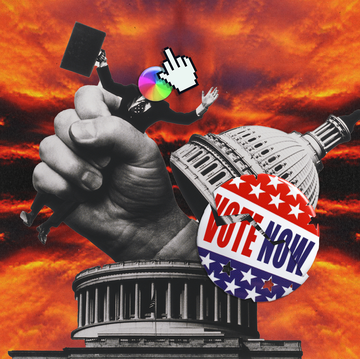April 12 is Equal Pay Day, the day that represents the more than three additional months it takes on average for women to earn the same wage that a white, non-Hispanic man in a similar position earns in just one year. Of course, that's just the simple explanation of what Equal Pay Day is — and it relies on a number of myths regarding the wage gap such as assuming the gap is equal for all women and at all points in their careers. Even if you're aware that there's a significant difference between what men and women make, and believe this is a problem, there's still a lot of misinformation floating around. Here's what so many people are getting wrong about the gender pay gap.
1. Women earn "77 cents per every dollar" compared to a man. This year, the wage gap has grown a little bit smaller and averages about 79 cents rather than the 77 cents that's often used in the media. That refers to the general gap you'll see between a white, non-Hispanic man and women overall in a similar job if all other factors are equal — a woman on average earns 21 cents less for every dollar her male colleague earns. But even that number is an average, and real wage gaps vary based on race, age, and even location, according to the National Women's Law Center. In Louisiana, the gap is biggest, with women on average earning only 65.3 cents for every dollar her Caucasian male counterpart brings home. In D.C., the gap is the narrowest, at 89.5 cents.
2. All women of color face an even bigger wage gap. This myth is almost true, but not entirely, and it definitely varies. In nearly every state, African-American women, Asian-American women, Latinas, and Native American women make less than the overall average for women, and in some cases, the difference is breathtaking. In Texas, a Latina earns just 44 cents per dollar, and in the progressive state of California, a Latina earns just 43. Latinas tend to fare the worst in the economy, with about a dozen states in the country paying them on average less than 50 cents on the dollar what Caucasian men earn. For Asian-American women, however, the gap is often less, and in states like Illinois and Tennessee, their own pay gap is actually narrower than that of all women on average.
3. There is no wage gap. Women just choose less lucrative jobs. Many people who decry the idea that there is a difference in pay based on gender say that in reality, women are just choosing jobs that don't make as much money. But when you break down salaries inside an industry itself, women still make less than men. Research released just last month analyzed salaries reported anonymously and divided them based on gender, and saw that in the tech industry, among dentists, and within senior executives, men tended to earn around 28 percent more than the women in their fields.
4. Women earn less because they take time off to have families. Women aren't earning less because they take time off to have children — they are earning less because companies assume they will prioritize their children over their work. In a study reported in Time Money that compared the wages of men and women that was adjusted to factor in experience, job title, education, and other factors, the pay gap between the genders was almost nonexistent when a single male and a single female were compared. Once those two employees were each married, however, the gap expanded to 1.6 percent — even though no one actually was having kids yet. When married women with kids were compared to married men with children, the gap grew to 4.2 percent. Now referred to as "The Motherhood Penalty," it has been consistently shown that men's wages go up when they have children, whereas married women's wages go down when they have them.
5. Women are giving up monetary compensation for more schedule flexibility. Are women earning less because they want more flexible schedules, less travel, and other job responsibilities? That could be contributing to the problem, but it isn't doesn't address the entire gap. According to economist Claudia Goldin, these issues may cause women to seek out certain career options that may exacerbate the gap (such as working as corporate counsel versus in a large law firm). Still, that doesn't account for the nearly immediate gap that begins even for those getting their first post-graduation jobs. More flexible schedules, better paid leave opportunities (for both parents), telecommuting, and in-office childcare are all ways that can help close a potential wage gap in earnings down the road, but the fact that these things aren't readily available is not the reason the gap exists in the first place. If that were the case, women wouldn't be earning 18 percent less straight out of college.
6. Women are just poor negotiators. The gap in wages between men and women get worse as time progresses, and many critics blame that on women being less aggressive when it comes to negotiating salaries — an issue that would make the gap grow exponentially with each performance review or job promotion. However, the reality is that there is gender bias at work. "Women are forced to toe a fine line between masculine and feminine when it comes to salary, and it seems they're sort of doomed either way," writes Gina Belli at Payscale, a career development and pay negotiation website. "If they don't ask — too feminine — they end up with lower salaries. If they do negotiate — too masculine — then they'll be seen as too aggressive, or just plain unlikable. A 2006 study, referred to as the Bowles study, found that when women negotiate their salaries, both men and women are less likely to want to work with or hire them. This effect was 5.5 times that faced by men who negotiated."
7. Women get paid less because they have less education. Nope. Not at all. There are actually more women graduating college than men, and more women getting master's, doctorates, and other degrees as well. Yet the more education an employee has, the greater the wage gap appears to be between men and women. According to Fast Company, "Higher education doesn't alleviate the difference in earnings. PayScale found that at the GED/high school grad level, the pay disparity is 2.3%, while PhDs have the highest controlled pay gap (5.15%), followed by MBA holders (4.7%), and MDs (4.6%)."
8. Executives are dedicated to hiring and promoting women. It's a harsh reality, but if two completely identical résumés are given to an employer, and one has a woman's name on top and one has a man's name on top, it's likely the man will be chosen for the interview. Ilene H. Lang, a former tech executive who now runs a research organization that studies women in the workforce, told MSNBC in February 2015, "Basically, if you take resumes and strip them of names and all gender information, then take the exact same resumes and put a man's name on some with links to a man, and put a woman's name on others with links to a woman, and send them out, hiring managers say that the women are unqualified and the men are terrific candidates. Men get the promotion or job and the women do not. Once you attach a gender link or a gender label, it gets devalued if it's female. This happens over and over again, and it is not because people are intentionally biased or intentionally sexist, but they do not see potential and leadership in women, particularly nonwhite women."
9. The Lilly Ledbetter Fair Pay Act fixed everything. Not even close, sadly. While the Lilly Ledbetter Fair Pay Act of 2009 was a massive step toward addressing the wage gap between the genders and provided concrete rules for ensuring pay equity — including extending the period of time for a person to sue over wage discrimination after discovering it — it still doesn't provide an avenue for stopping wage discrimination in the first place.
10. Well, then, maybe the pay gap can never be fixed. Actually, yes, it can, and there are a number of new ways to try to address it. It's virtually impossible to know you are even subject to wage discrimination without a clearer idea of what you are making in comparison to other employees at the same job, and new federal requirements will make that happen. President Barack Obama signed an executive action at the beginning of 2016 that "would require companies with 100 employees or more to report to the federal government how much they pay their employees broken down by race, gender, and ethnicity," according to the Atlantic. The information will be used to provide a new level of transparency and show employees how their own earnings compare, as well as dissuade companies from paying male employees better wages than their female workers or engaging in any other discriminatory pay practices. The new reporting should go into effect in 2017. Transparency closes wage gaps, and the hope is that in a few years, we will see that in action. But employment experts warn that while the new rules are welcome, they aren't necessarily a panacea for wage equality, as the data may still be difficult for employees to access and may not be position-specific enough to completely expose any gendered bias that still keep women earning less.
One piece of federal legislation that could help close the gap for good is the Paycheck Fairness Act. Introduced most recently in March 2015 by Sen. Barbara Mikulski, D-Md., and Rep. Rosa DeLauro, D-Conn., the bill would make it the employers' responsibility to prove they aren't discriminating based on gender when it comes to employee wages, allow workers to discuss their pay without fear of company retaliation, and make companies that pay women less than men subject to harsher penalties. The Paycheck Fairness Act has been stalled in both chambers of Congress, where it failed to make it out of committee.
Follow Robin on Twitter.












